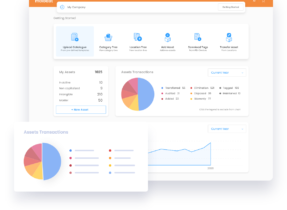What Makes a Good Asset Register?
Your business' Asset Register is very important and should be an integral part of running your company. If you don't have a robust Asset Register, you won't be able to manage your Fixed Assets and could even end up spending unnecessary money because you don't have a good enough asset tracking system in place. But what makes a good Asset Register? We'll explore the topic in this piece. Before we move on, let's recap on why an Asset Register is a necessary part of your company and discuss what you'll use it for.
Why You Need an Asset Register
Having an Asset Register is, as we've said, very important but if you don't know what to use it for, or how to use it, it's a pointless exercise! Here's why you need one in your business:
1. An Asset Register or Fixed Asset Management system is necessary if your business has a lot of Fixed Assets. Fixed Assets include buildings, machinery, vehicles, computers, software, furniture, and any other large item. These must be accounted for, audited, and maintained. Your Fixed Asset system will keep all information on every single Fixed Asset in one, easily accessible place.
2. Your accountants and auditors will need access to your Asset Register to calculate your balance sheets and make sure that your accounts are correct for audit purposes and other external connections, such as investors for example.
3. Your Asset Register is important for determining asset depreciation and is a part of Enterprise Fixed Asset Management.
4. An Asset Register is essential when you need to claim for Fixed Asset loss or damage plus it records all warranty information.
5. It's also essential for maintenance planning for your Fixed Assets and for recording when maintenance took place and by whom.
6. Those employees involved in maintaining your Fixed Assets require an Asset Register so they can plan their maintenance schedule.
7. An online asset tracking Asset Register can also help you see Fixed Assets that need improvement or replacement.
8. An Asset Register is excellent for identifying equipment and understanding their status at any given moment, as long as the register is kept up-to-date.
So, from the above, you soon understand why an Asset Register is an integral part of your business but what do you need to ensure that your Asset Register has all the components necessary for your business? A quality Asset Register should be able to:
1. Keep an eye on Fixed Asset Compliance, relating to safety of equipment, environmental compliance, financial compliance and any other compliance required
2. Through its tracking feature, immediately identify lost Fixed Assets or theft of Fixed Assets.
3. Help your business with its costs, help improve operations and ensure you're not wasting money unnecessarily.
4. Give you complete transparency so you can view all your Fixed Assets' data.
5. Keep all Fixed Asset audit information together so you can track auditing.
6. Estimate cost of maintenance, repair and disposal.
7. Calculate depreciation of each Fixed Asset.
Relying on a Spreadsheet is Not Enough
Your Asset Register should be a Fixed Asset Management Software System that has all the right tools built in – so you're ready to go! It should also be able to link to any other databases that you use, such as your accounting software as this gives your Fixed Assets even more visibility in your organization and helps with your balance sheet.
Some organizations think that just using Excel to document their Fixed Assets is enough, but the problem is that Excel isn't built for Fixed Asset Management and doesn't have the right tools to account for location, labelling, asset GPS tracking, maintenance schedules. Additionally, it's notoriously unreliable, plus, if you have multiple people using a spreadsheet at once, it's often locked for editing. That means that any updates that need instant recording get forgotten about and this leads to inaccuracy which can impact your business' profit. So, investing in a quality Fixed Asset Management system that uses automation will improve your systems and give you immediate access to anything you need related to each Fixed Asset.
When you purchase a Fixed Asset Management system, you need to think about the following as a good system will be able to:
- Know what each Fixed Asset is and what it's used for with a full description.
- Assign each Fixed Asset with a barcode, print barcode labels and attach GPS tracking.
- Locate every Fixed Asset at any time (using online tracking) for easy asset counting.
- Provide procurement information, such as purchase date, price, warranty etc.
- Be able to forecast life expectancy and calculate depreciation value (and remaining life of asset) as well as understand current value.
- List estimated resale value of each Fixed Asset (often referred to as Salvage Value).
- Keep all insurance details and instruction details in one place.
- Record maintenance history.
- Keep a history of employees who've used each Fixed Asset and when (users of Fixed Assets).
- Be able to be used on-the-go, with an asset handheld application.
- Assign RFID tags to each Fixed Asset for audit purposes.
Other Important Elements To Consider When Choosing an Asset Register
Avoiding Lumpsum Data
Most of financial registers contains a lumpsum data, this happens when the financial team capitalize a group for fixed asset in one financial record (like capitalizing the General Manager office or fifty laptops without mention it one by one). Accordingly, the team will face problems when they need to transfer, count, or dispose a part on these composed assets.
Asset Hierarchy
A quality Asset Register should be able to build a hierarchy (Asset Catalogue) of your Fixed Assets and the reason for this is it helps anyone using the register to find a Fixed Asset, without its barcode or name. A hierarchy of assets will also help you to place assets in a category and group and this enables you to place a default value on a group of assets, to archive a group of assets and also to plan maintenance on a group of Fixed Assets.
Create a Coding System
For businesses that have large numbers of Fixed Assets, it's imperative that each asset has its own name and number – or assets' barcoding so at any time, it's easily identifiable. A premium Fixed Asset Management System such as Mojodat will automatically allocate barcodes to each Fixed Asset. This system can even print barcode labels and use asset tracking so you can easily locate a Fixed Asset too.
Updating Your Asset Register
Of course, every Asset Register needs to be kept up-to-date and this is crucial because if there is any missing or inaccurate data, you won't be able to quickly locate a Fixed Asset and you might even have a number of ghost assets that are unaccounted for but you're still paying out insurance premiums. A system that's specifically designed for Fixed Asset Management will use a lot of automation which frees up your employees to carry out other business-related tasks. However, all Fixed Asset Management systems need some manual updating but if you use a register with an asset mobile application, you can update information on the go, rather than waiting to sit in front of a desktop. This makes it a seamless operation and much easier to manage than manual spreadsheets.
Finally, if you're currently looking for a Fixed Asset Management system, take into account all of the above. When you do purchase your system, ensure that guidelines are put into place for the use of the system, so all personnel involved understand the processes. This helps ensure that critical information is up-to-date and that your Asset Register is utilized properly by all so it works as efficiently as possible.
Subscribe to read the full article below.


